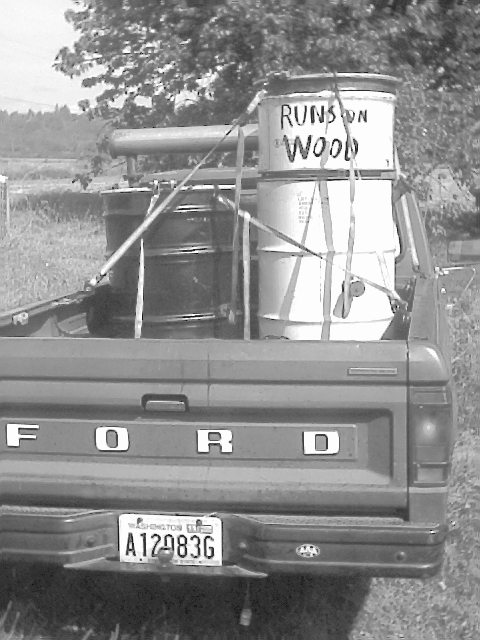From the May 2006 Idaho Observer:
‘85 Ford Ranger getting 40 miles to the pound

Dowden's '85 Ranger is rolling proof that our dependance on oil travel is a myth.
Seattle area innovator powers his truck with gasoline or wood
Since meeting Timm Dowden at the 9/11 Visibility Project event at the University of Washington April 1, 2006, we have really come to appreciate Dowden for his ingenuity and the principles that serve as his inspiration. Along with a CD containing numerous photos and various pieces of text, Dowden sent "The End of Suburbia"—a very sobering documentary about the forces that tamed the wilds of North America with urban sprawl. Dowden has chosen to life his life in a way that allows him to be part of the modern world while leaving as light a footprint as possible. One of the ways he has lightened the burden his life places on the world is to adapt decades-old "gasification" technology to his 1985 Ford Ranger. Though wood is not as dense a fuel a gasoline and, therefore, does not produce the horsepower, it does burn clean. In honor of the tinkerers in our midst Dowden is actually (not hypothetically) running his truck on gasoline and, at the flip of a switch, running on wood—at about 40 miles to the pound. Dowden says that any auto mechanic with metal fabrication skills can make stopping at gas stations optional.
by The Idaho Observer
Depending on how you look at it, the dollar is either losing its purchasing power or the cost of items available for purchase is going up. In either event the price one must pay for nearly everything is increasing and those increases are tied directly to the amount we pay for gasoline. Aside from the costs in dollars per gallon, billions of dollars are spent bombing cities and killing innocent people to secure a stable (and supposedly inexpensive) supply of gasoline and the thousands of other products made from crude oil. The world is paying yet an even higher price for gasoline as the byprodutcs of its combustion are accumulating in toxic quantities at strategic locations—air, land, water, food and in body tissues.
Like it or not, it is a foregone conclusion among those who can see past their own lifespan that the age of oil will come to an end—on our terms because we want to survive or on its terms when we perish.
Aside from concerns tht we aren’t smart enough to prevent the oil age from killing us, our world is changing fast; global political and economic stability is so tenuous at this time that, beginning tomorrow, the supply of gas could become so limited that it will rationed out to the highest bidder.
Pondering the second scenario, most people just assume that they will be walking and riding bikes when the gas pumps go dry. While that will be true to a large extent, it is not a fate that must be accepted as if there are no alternatives. Modern innovators can revive a concept that was born with the automobile, but allowed to die when oil interests took over the automobile and related industries.
This article will not attempt to go into the details of how gasification works. It is only meant to say that it does work and any auto mechanic with metal fabrication skills can adapt gas engines to run on wood—or coal, wood pellets, cow pies, corn husks or road apples.
"What I’ve done is build a simple, emergency-only style, biomass gasification unit for my ’85 Ford Ranger truck. This is not a new technology that is going to save the world or make you a million dollars, but it may get you through a fuel crisis relatively intact. And a fuel crisis is what we’re heading for," Dowden said.
Dowden emphasized that gasification of combusible materials is a readily-available source of emergency fuel, but is not a long-term solution. As you can see from the photo at left and the three photos below, the components for a gasifier unit can be comprised almost completely of recycled materials that cost very little.
Dowden describes his gasifier as "a large hookah—load the bowl, light it and the engine sucks it down. The trick," he continues, "is to burn combustibles (wood, corn, hazelnut shells and, yes, dried manure, but it’s got to be really dry!) in an oxygen-starved environment. The resultant gasses of combustion are carbon dioxide and water, CO2 & H2O. It doesn’t really matter what you’re burning, if you burn it well these are the gasses you get. Now if you restrict the oxygen (we’ll just call it air) you get one oxygen atom less in the equation. So CO2 becomes CO (carbon Monoxide) and this is flammable as well as being deadly poisonous. And the H2O becomes H2 (hydrogen gas). So, the resultant gasses of burning most anything with too little air is CO and H2, a beautifully flammable gas—just don’t breathe it!"
These are the gasses that power Dowden’s truck. He has airtight barrels and tubing that make the gas generator (hookah) and more barrels and tubing comprise the filter, cooler, and piping to the engine. "The gas needs to be cleaned properly before running it in your engine, otherwise your engine won’t last long. I know of what I speak and I am still learning how to filter and dry the gases better. It is all part of the learning process and that’s why I’m doing this experiment now, before we find ourselves in the middle of a crisis," Dowden said.
According to Dowden, "It generally takes between two and five minutes before I can switch over to wood gas. I have a switch in the wire to my fuel injectors that cuts the power and they just stop. So when I turn off power to my injectors and the engine keeps running I know it’s running on wood-gas. And should the unit give me any troubles while underway, I just switch the gas back on and instantly I have a gasoline engine again. Really. It’s that easy."
The one drawback is that the top speed Dowden has achieved with wood gas is 60 MPH and may reach a top speed of 25 MPH going uphill.
The best way to get more information is to go online and visit the website at www.gengas.nu/byggbes/ix/shtml. You can also email Dowden at Timmdowden@aol.com.
Dowden also sent along a link to Lindsay Press in Illinois. Lindsay reprinted the 1943 book, "Producer Gas for Motor Vehicles" by John D. and Martin G. Cash of Australia. In the preface, the authors explain how the dangers of the "petrol" supply being cut off and the need for the citizenry to minimize petrol consumption in support of the war effort "...may well be....the gas producers’ greatest service to Australia..."
Producer Gas for Motor Vehicles (194 pp.) is available for $12.95 through Lindsay Press, PO Box 538, Bradley, IL 60915 (815) 935-5353 www.lindsaybks.com

Home - Current Edition
Advertising Rate Sheet
About the Idaho Observer
Some recent articles
Some older articles
Why we're here
Subscribe
Our Writers
Corrections and Clarifications
Hari Heath
Vaccination Liberation - vaclib.org